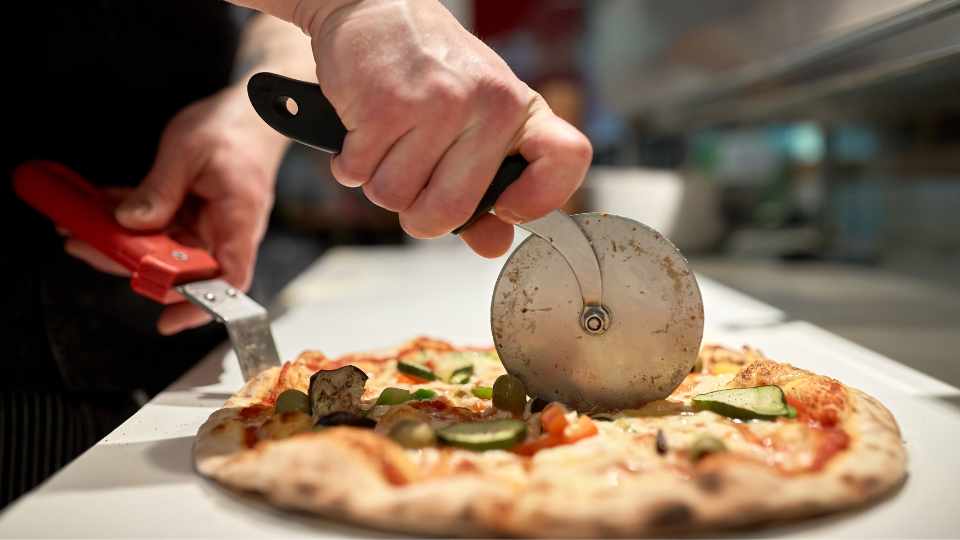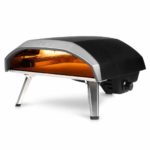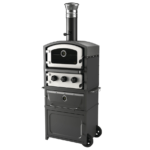How to Use a Pizza Peel Without Sticking (Quick Tips)
Visit any Neapolitan pizzeria in Naples, Italy, and you are sure to be treated to the wonderful sights, sounds, and smells.
Right in the centre of that quaint venue is a massive, wood-fired oven. Milling around it is a couple of pizzaiolos, the talented craftsmen kneading dough, twirling it into shape, and topping it with a generous serving of the simplest ingredients. They then take this paddle, skilfully inserting the thin wood under the dough, and slipping the uncooked pizza into the depths of the hot oven.
Whether you see this live or on some travel show you’re watching on TV, you start to think: that’s easy, I can do all that at home. I just need that rustic-looking paddle and I’ll get fresh pizza every single time.
The Pizza Paddle / Shovel / Peel
That device with a flat base and long handle, used to transfer the pizza to and from the oven is called a pizza peel (a.k.a paddle or shovel).
It is typically made of wood, metal, or a combination of both. The surface is large enough to hold a pizza while the handle is long enough to reach the back of the oven without scorching the user’s extremities.
While it seems like a single-function tool, this is a must-have in any professional restaurant or bakery for deftly moving the pizza around without deforming the dough or spilling its toppings, and for safety reasons.
It’s Not as Easy as It Looks
If there’s one thing that surprises many about the pizza peel, it’s that it is quite a challenge to use. Just the motion of inserting the peel under the dough could cause a whole lot of problems, ruining your dish altogether.
Don’t worry, practice does make perfect. Even the most skilled pizzaiolo wrecked a dozen or so pies when they were just starting to learn the craft. But lucky you, we’ve got some great tips that could help make this job a bit easier, even for beginners.
How to Use a Pizza Peel Without Sticking (Must-Try Techniques)

Place the edge of the peel on the surface where your pizza is at an angle
Much like an actual shovel used for digging soil, you can scoop the pizza better in one smooth motion instead of carefully sliding it under the flattened dough.
Simply insert the edge of the paddle under the section of the dough and push the rest in. If you’re confident that your dough won’t tear, you could carefully pull it over the peel as well.
Sharpen the edge of the peel with a steel rod
The thinner the edge is, the easier it is to slip under the dough. It doesn’t have to be sharp like a knife, just honed enough that it would quickly scrape over the board. Obviously, this is only possible with a metal peel and not with the wood and composite variants.
Make sure the surface is completely dry
Even the slightest moisture on your board will cause the dough to stick to it, making the transfer difficult. Wiping the surface clean with a dry towel is a must-do. Sprinkling fine semolina flour over your work surface really helps as well.
Some recommend dusting the peel with a bit of cornflour as well. But to be honest, this is just a waste of good flour. It won’t be needed if your prep surface is dry, to begin with.
Flatten your dough over the semolina
Tossing the dough is great if you have the skill to do so. Otherwise, it’s best to flatten the dough onto the board covered with cornflour instead of using a rolling pin.
Simply roll it around in a clockwise motion (or counter-clockwise, whichever you’re comfortable with) until you reach your preferred crust thickness.
Holes on the dough will cause it to stick to the peel and the oven
Sauces could seep through those holes, causing the bottom of the dough to get wet and stick to surfaces.
It’s even harder when this happens inside the oven because the burnt sauce and cheese act like glue between the crust and the hot surface. If you accidentally tore a portion of the dough, you will have to stay beside the oven and use the peel to slowly rotate the pizza around so it won’t stick.
What Makes a Good Pizza Peel?
This essential tool comes in different shapes and sizes these days. You should consider your personal need (more than your wants) when shopping for one because it’s not the most versatile kitchen item. Here are some factors to consider:
Material
The handle is almost always wooden so that you can safely hold it without fearing for your fingers. The base, on the other hand, is made of different materials:
- Wood
Most cooks prefer this because the dough doesn’t stick to it, even without a sprinkling of cornmeal. It also lends an authentic air to that rustic restaurant milieu. But because the thinnest wood is still relatively thick, it’s hard to master the basic motion of flipping it under the dough, causing damage to your pizza. It’s also a pain to clean because wood requires seasoning.
- Metal
Thinner, flatter, easy to clean, and more long-lasting, this is becoming a bigger favourite among professionals these days. The only trouble here is that dough sticks to it fast so you will definitely need that cornmeal dusting and a very good flick of the wrist to get the flat dough onto it and into the oven.
- Wood Composite
This looks like wood but, with the addition of resin, is thinner and won’t require the tedious scrub, rinse, and season clean-up. Despite these advantages, not a lot of professional kitchens use this because it’s quite heavy.
Size
The dimension of the flat base usually follows pizza circumferences so this would range from 12 inches to 20 inches.
Paddle Shape
Rarely will you find a circular paddle. Most are squarish, either with a straight edge or a slightly curved end. The most important thing here is that the sides are parallel to one another, keeping the whole pizza in place.
As aforementioned, it’s important that you go for what you need. If you’re a restaurant owner, go ahead and get the largest wooden paddle with a long handle. But if you’re a home cook, a small wood-resin composite peel would do.






